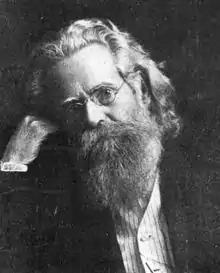Moses Harman
Moses Harman (October 12, 1830 – January 30, 1910) was an American schoolteacher and publisher notable for his staunch support for women's rights. He was prosecuted under the Comstock Law for content published in his anarchist periodical Lucifer the Lightbearer. He was arrested and jailed multiple times for publishing allegedly obscene material. His daughter, Lillian Harman, was also a notable anarchist.
Moses Harman | |
|---|---|
 | |
| Born | October 12, 1830 |
| Died | January 30, 1910 (aged 79) Los Angeles, California, US |
| Nationality | American |
| Occupation | Schoolteacher, publisher |
| Known for | Anarchism, women’s rights |
| Children | Lillian Harman |

Biography
Moses Harman was born on October 12, 1830 in Pendleton County, West Virginia[1] to Job and Nancy Harman. Their family later moved to Crawford County, Missouri. Harman taught subscription school courses and attended Arcadia College. After completing his schoolwork, Harman worked as a Methodist circuit rider and teacher.[2]
Harman married Susan Scheuck in 1866. Although they had several children, only two survived and Susan died in childbirth in 1877. Harman left the ministry and began his involvement with eugenics and social reform following Susan's death. In 1881, Harman edited the Kansas Liberal newspaper in Valley Falls, Kansas.[2]
Harman has been credited as one of the founders of what became the eugenics movement. "He gave the spur and start to this effort. Through his journals, Lucifer, the Light Bearer, later renamed The American Journal of Eugenics, encouraged by a small circle of earnest men and women, he dug down below the surface endeavoring to bring forth a stronger and better type of men".[3]
In 1881, Harman co-edited the Valley Falls Liberal, and eventually became the editor. On August 24, 1883, Harman changed the name of the publication to Lucifer, the Light Bearer. He moved the location of the newspaper several times for financial and philosophical reasons: to Topeka, Kansas in 1890, to Chicago in 1896, and to Los Angeles in 1908. The name of the paper also changed to The American Journal of Eugenics in 1906.[1]
Articles published in Lucifer discussed topics such as religion, relationships, and raising children.[2] Through his work, Harman rejected all forms of religion and government, including marriage, and promoted freedom, love, wisdom, and the use of knowledge. Due to the radical nature of his views and publication, Harman constantly dealt with lawsuits, charges of immorality, ridicule, and issues with mailing what was considered obscene material through the United States Postal Service. Consequently, Harman was sentenced and released by courts several times in the 1890s.[1]
He died on January 30, 1910, aged 79, in Los Angeles.[4]
References
- "Moses Harman". Kansapedia. Kansas Historical Society. Retrieved 20 November 2013.
- "C3802 Harman, Moses (1830-1910), Papers, 1858-1984" (PDF). The State Historical Society of Missouri. Archived from the original (PDF) on 10 June 2015. Retrieved 20 November 2013.
- The Naturopath and Herald of Health, March 1914
- "Dagger In heart, Last Will". Chicago Tribune. January 31, 1910.
Moses Harman Dies in Los Angeles at the Age of Nearly 80. ... Moses Harman, one of the pioneers of the eugenics movement in America, died yesterday in Los ...
Further reading
- Herrada, Julie (2007). "Harman, Moses". In Dawkins, Richard (ed.). The New Encyclopedia of Unbelief. Prometheus Books. pp. 378–379. ISBN 978-1-61592-280-2.
- West, William Lemore (Spring 1971). "The Moses Harman Story". Kansas History. 37 (1): 41–63.
External links
- Works by or about Moses Harman at Internet Archive
- Moses Harman: A Kansas Portrait from the Kansas State Historical Society
- Moses Harman: The Paradigm of A Male Feminist by Wendy McElroy
- Sex Slavery by Voltairine de Cleyre, an 1890 essay supporting Harman and attacking the institution of marriage